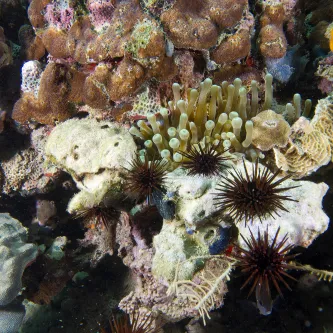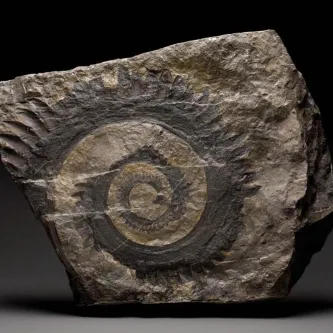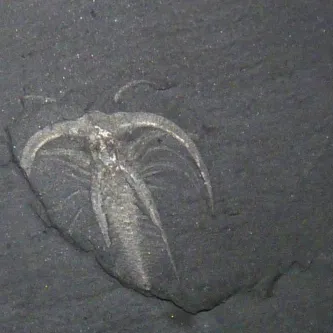Search
Early Life on Earth – Animal Origins
In the Beginning
Today we take for granted that we live among diverse communities of animals that feed on each other. Our ecosystems are structured by feeding relationships like killer whales eating seals, which eat squid, which feed on krill. These and other animals require oxygen to extract energy from their food. But that’s not how life on Earth used to be.
With an environment devoid of oxygen and high in methane, for much of its history Earth would not have been a welcoming place for animals. The earliest life forms we know of were microscopic organisms (microbes) that left signals of their presence in rocks about 3.7 billion years old. The signals consisted of a type of carbon molecule that is produced by living things.
Evidence of microbes was also preserved in the hard structures (“stromatolites”) they made, which date to 3.5 billion years ago. Stromatolites are created as sticky mats of microbes trap and bind sediments into layers. Minerals precipitate inside the layers, creating durable structures even as the microbes die off. Scientists study today’s, rare living stromatolite reefs to better understand Earth’s earliest life forms.
An Oxygen Atmosphere
When cyanobacteria evolved at least 2.4 billion years ago, they set the stage for a remarkable transformation. They became Earth’s first photo-synthesizers, making food using water and the Sun’s energy, and releasing oxygen as a result. This catalyzed a sudden, dramatic rise in oxygen, making the environment less hospitable for other microbes that could not tolerate oxygen.
Evidence for this Great Oxidation Event is recorded in changes in seafloor rocks. When oxygen is around, iron reacts chemically with it (it gets oxidized) and gets removed from the system. Rocks dating to before the event are striped with bands of iron. Rocks dating to after the event do not have iron bands, showing that oxygen was now in the picture.
After the initial pulse of oxygen, it stabilized at lower levels where it would remain for a couple billion years more. In fact, as cyanobacteria died and drifted down through the water, the decomposition of their bodies probably reduced oxygen levels. So, the ocean was still not a suitable environment for most lifeforms that need ample oxygen.
Multicellular Life
However, other innovations were occurring. While they can process lots of chemicals, microbes did not have the specialized cells that are needed for complex bodies. Animal bodies have various cells – skin, blood, bone – which contain organelles, each doing a distinct job. Microbes are just single cells with no organelles and no nuclei to package their DNA.
Something revolutionary happened as microbes began living inside other microbes, functioning as organelles for them. Mitochondria, the organelles that process food into energy, evolved from these mutually beneficial relationships. Also, for the first time, DNA became packaged in nuclei. The new complex cells (“eukaryotic cells”) boasted specialized parts playing specialized roles that supported the whole cell.
Cells also began living together, probably because certain benefits could be obtained. Groups of cells might be able to feed more efficiently or gain protection from simply being bigger. Living collectively, cells began to support the needs of the group by each cell doing a specific job. Some cells were tasked with making junctions to hold the group together, while other cells made digestive enzymes that could break down food.
The First Animals
These clusters of specialized, cooperating cells eventually became the first animals, which DNA evidence suggests evolved around 800 million years ago. Sponges were among the earliest animals. While chemical compounds from sponges are preserved in rocks as old as 700 million years, molecular evidence points to sponges developing even earlier.
Oxygen levels in the ocean were still low compared to today, but sponges are able to tolerate conditions of low oxygen. Although, like other animals, they require oxygen to metabolize, they don’t need much because they are not very active. They feed while sitting still by extracting food particles from water that is pumped through their bodies by specialized cells.
The simple body plan of a sponge consists of layers of cells around water-filled cavities, supported by hard skeletal parts. The evolution of ever more complex and diverse body plans would eventually lead to distinct groups of animals.
The assembly instructions for an animal’s body plan are in its genes. Some genes act like orchestra conductors, controlling the expression of many other genes at specific places and times to correctly assemble the components. While they were not played out immediately, there is evidence that parts of instructions for complex bodies were present even in the earliest animals.
Thanks to their hard skeletons, sponges became the first reef builders on Earth. Scientists like Smithsonian’s Dr. Klaus Ruetzler are working to understand the evolution of the thousands of sponge species living on Earth today.
Ediacaran Biota
By about 580 million years ago (the Ediacaran Period) there was a proliferation of other organisms, in addition to sponges. These varied seafloor creatures - with bodies shaped like fronds, ribbons, and even quilts - lived alongside sponges for 80 million years. Their fossil evidence can be found in sedimentary rocks around the world.
However, the body plans of most Ediacaran animals did not look like modern groups. Smithsonian’s Dr. Douglas Erwin, using comparative developmental evidence, has examined whether any of the fossilized Ediacaran animals were related to modern animals.
By the end of the Ediacaran, oxygen levels rose, approaching levels sufficient to sustain oxygen-based life. The early sponges may actually have helped boost oxygen by eating bacteria, removing them from the decomposition process. Tracks of an organism named Dickinsonia costata suggest that it may have been moved along the sea bottom, presumably feasting on mats of microbes.
The End-Ediacaran Extinction
However, about 541 million years ago, most of the Ediacaran creatures disappeared, signaling a major environmental change that Douglas Erwin and other scientists are still working to understand. Evolving animal body plans, feeding relationships, and environmental engineering may have played a role.
Burrows found in the fossil record, dating to the end of the Ediacaran, reveal that worm-like animals had begun to excavate the ocean bottom. These early environmental engineers disturbed and maybe aerated the sediment, disrupting conditions for other Ediacaran animals. As environmental conditions deteriorated for some animals, they improved for others, potentially catalyzing a change-over in species.
The Cambrian Explosion
The Cambrian Period (541-485 million years ago) witnessed a wild explosion of new life forms. Along with new burrowing lifestyles came hard body parts like shells and spines. Hard body parts allowed animals to more drastically engineer their environments, such as digging burrows. A shift also occurred towards more active animals, with defined heads and tails for directional movement to chase prey. Active feeding by well-armored animals like trilobites may have further disrupted the sea floor that the soft Ediacaran creatures had lived on.
(Watch video, "The Cambrian Explosion of Life with Paleontologist Karma Nanglu.")
Unique feeding styles partitioned the environment, making room for more diversification of life. In 1909 the Smithsonian’s fourth Secretary, Charles Doolittle Walcott, discovered the Burgess Shale fossils that revealed the unprecedented biodiversity of Cambrian life. While Waptia scoured the ocean bottom, priapulid worms burrowed into the sediment, Wiwaxia attached to sponges, and Anomalocaris cruised above.
Many of these odd-looking organisms were evolutionary experiments, such as the 5-eyed Opabinia. However, some groups, such as the trilobites, thrived and dominated Earth for hundreds of millions of years but eventually went extinct. Stromatolite reef-building bacteria also declined, and reefs made by organisms called brachiopods arose as conditions on Earth continued to change. Today’s dominant reef-builders, the hard corals, did not emerge until a couple hundred million years later
However, despite all the changes that were to come, by the end of the Cambrian nearly all existing animal types, or phyla, (mollusks, arthropods, annelids, etc.) were established, and food webs were emerging, forming the foundation for the ecosystems on Earth today.






